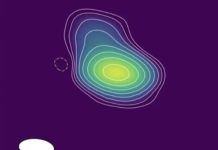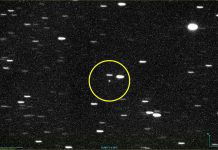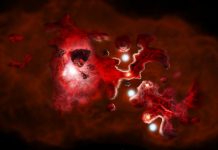
Imagine a giant cosmic factory where planets are born.
That’s what astronomers have recently observed, and it’s pretty exciting!
Using a powerful telescope in Chile, they’ve spotted something unusual around a young star named HD 144432, which is 500 light-years away from us.
This star has a special disk around it where planets are forming, and what’s unique is that this disk has three rings made of iron!
Let’s talk about these rings. You know how we have different planets like Mercury, Mars, and Jupiter in our solar system?
The rings around this star are kind of in similar places. The first one is close to where Mercury would be, the second near Mars, and the third around where Jupiter orbits. This is a big deal because usually, such rings are found much farther out, like where Saturn is in our solar system.
Now, what does this all mean?
These rings suggest that planets are being formed. The gaps between the rings might be where planets are growing, gathering dust and gas. The scientists think that there might be two planets forming there, each about the size of Jupiter.
What’s really cool is that the dust in these rings is similar to what we find on Earth and other rocky planets. It’s made of things like silicates (that’s metal mixed with silicon and oxygen) and other minerals.
They even think there might be metallic iron, like what we have in the cores of Mercury and Earth. This discovery is super special because it’s the first time iron has been found in a planet-forming disk.
Usually, when scientists look at these space disks, they see a mix of carbon and silicate dust. But here, it’s more about iron and silicates, especially in the hot areas close to the star. The dust can get really hot, up to 1500 degrees Celsius, and that’s where minerals and iron melt and turn into crystals. If there were carbon grains, they’d just burn up and turn into gases like carbon monoxide or dioxide.
This finding is important because it shows that the conditions around this young star might be similar to how our solar system was when it was young. Our solar system has planets like Earth and Mercury that are rich in iron but don’t have much carbon. So, this new discovery might mean that our solar system isn’t that unique after all.
How did they find all this out?
Well, they used a technique called interferometry. This is where they combine observations from several telescopes to get really detailed images. It’s like using a giant super telescope. They used this method at the Very Large Telescope Interferometer (VLTI) in Chile, which is part of the European Southern Observatory.
This discovery isn’t just about one star. The scientists have other stars they want to study with the VLTI to see if they also have iron-rich disks where planets are forming.
If they find more examples, it could tell us a lot about how common our type of solar system might be in the universe. Isn’t that fascinating?



